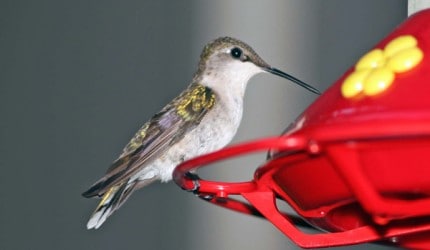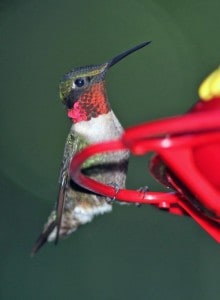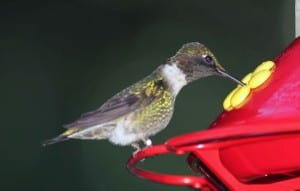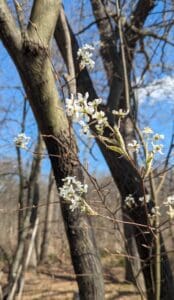
(Chelsea Update would like to thank Tom Hodgson and the Waterloo Natural History Association for the information and photos in this column.)
Over 300 bird species visit or reside in Michigan every year, but none are more interesting or unique than the diminutive ruby-throated hummingbird.
This, the smallest bird nesting east of the Rocky Mountains, weighs about as much as a penny. It is also the only bird with helicopter-like flying abilities. It can fly backwards, hover and change its position vertically in space with ease. It and can also go from full speed ahead to a complete stop in mid-air, and fly upside down.

We all remember that third-grade joke about why hummingbirds hum? Because they don’t know the words. It’s really because in flight their wings beat over 50 times per second, creating an insect-like hum. They are so confident in their flying abilities they seem to have little fear of humans. This is great for those of us who enjoy watching them as they are not intimidated by our presence in the garden.
Although there may be other birds that are more colorful, there are none that make better use of iridescent colors than the hummingbird. Special structures in its feathers scatter the light, neutralizing some colors and reflecting others. Such colors are called structural colors, not the result of an actual pigment.
The emerald green color on the hummingbird’s back is structural, as is the gorgeous red on the male’s throat. The actual underlying pigment on the male’s throat is black or melanin, which is why the throat patch often appears black. But when the bird turns and faces you, that black turns to fiery-red. That beautiful red throat patch or gorget is used to impress the females during courtship, and perhaps to intimidate other hummers when a male is defending its feeding territory.
Hummingbirds are very attracted to red or orange flowers, especially if they are tubular. They will also visit other flowers. The pale blue hosta blossoms in my back yard are popular with hummers right now. Hummers get much of their energy food from nectar, but also eat insects and spiders.

They are, of course, also attracted to hummingbird feeders filled with a sugar and water solution. Can they get along without these feeders? Absolutely. The primary benefit from hummingbird feeders is the enjoyment we get from watching the birds. In most years, there is plenty of natural nectar out there to satisfy the birds.
Can the feeders be harmful to the birds? Not if properly placed and maintained. The sugar solution should be made from one part table sugar and four parts water, i.e. one cup of sugar to four cups of water. Although some commercial pre-mixed “hummingbird nectar” contains red food coloring, it is not recommended. Plain old sugar and water is the best. Heat about five cups of water to boiling in a pan, remove from the heat. Pour four cups of this very hot water into another container, add one cup of sugar and stir till it is completely dissolved.
The heat will drive off any chlorine from city water and will kill mold and yeast spores that might be in the sugar. This will help the solution to keep longer. Allow the solution to cool and then pour it in a storage container and place in the refrigerator until needed.

The hotter the summer temperatures the more frequently the solution should be replaced and the feeders cleaned, in Michigan that means once every two or three days. To avoid wasting the sugar solution put only small quantities into the feeder until the amount of daily use can be determined. The sugar solution will stay fresh longer if the feeders are placed in the shade.
Feeders can be put up in early May and remain until the end of September. Feeding later in the fall is possible and will not cause hummingbirds to extend their stay.
Next week, we will visit with a hummingbird bander and researcher to see how the banding is done and to learn more about the life of hummingbirds and their migration travels.















Hopefully, next week Tom’s column will reveal the age of the oldest ruby-throated hummingbird on record, recently banded right here in WATERLOO! Until next week, take a guess at how old this tiny bird is, and how many miles it (he or she? guess!) has flown on its migration!